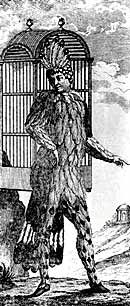![]() At
a glance
At
a glance
![]() Cast
list
Cast
list
![]() Programme
notes
Programme
notes
![]() Pictures
Pictures
Programme notes
 Die
Zauberflöte
- The Magic Flute
- is one of the three most-performed operas in the world (the other two
are Tosca
and Bohème).
It's certainly a candidate for the most popular. But its phenomenal
success would have surprised Emanuel
Schikaneder, the
actor-singer-impresario and self-promoter who wrote the libretto,
played Papageno (in the
picture from the playbill of the first performance, right),
and managed to rope in a busy Mozart
to supply the music in summer 1791. Schikaneder was not trying to
create 'a masterpiece', but simply churning out another money-spinning
mix of dialogue, singing, pantomime, mystical mumbo-jumbo and drama, to
appeal to Vienna's middlebrow audiences of the time.
Die
Zauberflöte
- The Magic Flute
- is one of the three most-performed operas in the world (the other two
are Tosca
and Bohème).
It's certainly a candidate for the most popular. But its phenomenal
success would have surprised Emanuel
Schikaneder, the
actor-singer-impresario and self-promoter who wrote the libretto,
played Papageno (in the
picture from the playbill of the first performance, right),
and managed to rope in a busy Mozart
to supply the music in summer 1791. Schikaneder was not trying to
create 'a masterpiece', but simply churning out another money-spinning
mix of dialogue, singing, pantomime, mystical mumbo-jumbo and drama, to
appeal to Vienna's middlebrow audiences of the time.
At first glance, his plot looks a jumbled nonsense. It does at most further glances, too. In essence, Zauberflöte is a 'buddy movie' set in some vaguely Egyptian legendary past: Tamino (a prince, the straight man) and Papageno (a yokel, the funny man) team up to win their respective sweethearts, Pamina and Papagena. To do so they have to go through various initiation ceremonies set up by some priests they run into. Along the way we also have murderous intrigue involving baddies who turn out to be goodies (Sarastro, the head priest) and goodies who turn out to be baddies (Queen of the Night, Pamina's mother).
So how come it has proved so popular? Partly it's the odd mix of the thing. On the one hand, it's a celebration of the Enlightenment: that remarkable new wave of social tolerance, equality and liberated thinking that set Western society on its modern secular, democratic path. All its ideals greatly appealed to Mozart. Both society and individuals are better at the end of the opera, after their self-testing ordeals. Yet on the other hand, it's a slapstick comedy with pantomime magic bells and flutes. Schikaneder's libretto is a derivative old rag-bag, but it's had enough to it to appeal to directors over the centuries.
 But mainly, of course, what has made The
Magic Flute endure is the
music. Mozart (pictured
in the engraving by Doris Stock from 1789, said to be the best likeness
of the composer) was a man
equally at home playing pool over a beer with his chums as he was
discussing politics or art in the highest social and intellectual
circles; possibly only he could have written music of such a wide range
of styles, yet also such quality. Everywhere the notes flesh out the
characters in a way beyond that of acting and words. Tamino's music,
like him, is earnest and cultured; Pamina's is graceful and beautiful.
Papageno, though - who doesn't care about moral or social progress, and
just wants a decent job, pretty wife and a glass of wine or two with
dinner - has unpretentious, bouncy popular tunes. Monostatos, a bully
and sexual abuser, shouts in disconnected, crude fragments. Sarastro,
the priestly patriarch, has controlled melodic gravitas; the Queen of
the Night, a vindictive harpie, is vertically unhinged and intense,
most notoriously in her manic top F (yes, that
F) vengeance aria in Act II.
But mainly, of course, what has made The
Magic Flute endure is the
music. Mozart (pictured
in the engraving by Doris Stock from 1789, said to be the best likeness
of the composer) was a man
equally at home playing pool over a beer with his chums as he was
discussing politics or art in the highest social and intellectual
circles; possibly only he could have written music of such a wide range
of styles, yet also such quality. Everywhere the notes flesh out the
characters in a way beyond that of acting and words. Tamino's music,
like him, is earnest and cultured; Pamina's is graceful and beautiful.
Papageno, though - who doesn't care about moral or social progress, and
just wants a decent job, pretty wife and a glass of wine or two with
dinner - has unpretentious, bouncy popular tunes. Monostatos, a bully
and sexual abuser, shouts in disconnected, crude fragments. Sarastro,
the priestly patriarch, has controlled melodic gravitas; the Queen of
the Night, a vindictive harpie, is vertically unhinged and intense,
most notoriously in her manic top F (yes, that
F) vengeance aria in Act II.
But there's also the happy end. No-one dies after being stabbed and then singing about it for ten minutes. In fact, nobody really dies at all: Monostatos, the Queen of the Night and her henchpersons all disappear at the end in a clap of thunder, but it's more a symbolic kind of thing - Wisdom and Enlightenment winning over the old ways of sycophancy, brute force and vengeance.
And the goodies get their reward. Tamino gets his Pamina, and - in the most appealingly daft duet in all of mainstream opera - Papageno gets his Pa-pa-pa-pa-pa-pa-papagena. Silly but serious, popular yet profound: what goes for their duet goes for the opera as a whole. Perhaps only Mozart could attempt all this - and make it work so well.
© Rob Ainsley 2006










